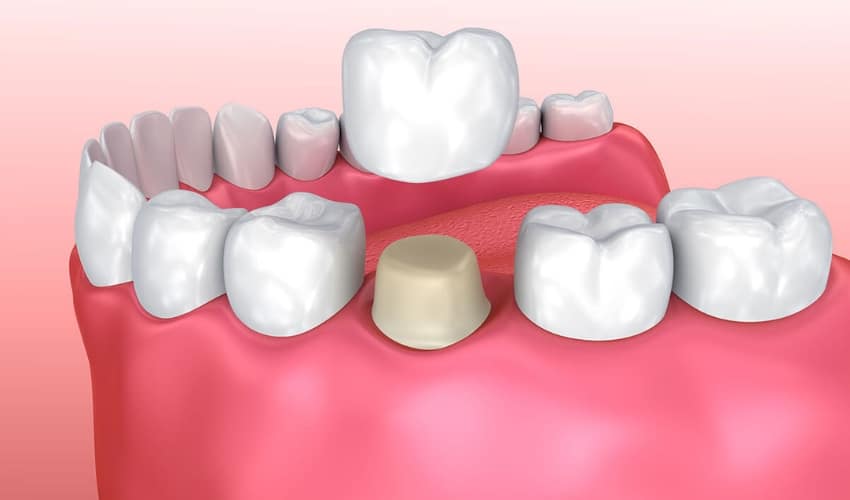
Are you dealing with a dental crown that is starting to feel loose or uncomfortable? It could be due to the dental cement used to secure it. Dental cement is an adhesive material commonly used by dentists to bond crowns on teeth, providing stability and durability. However, there are instances when you may need to remove the dental cement from your crown for various reasons. In this blog post, we will explore the process of removing dental cement from a crown and provide helpful solutions for handling this situation. So please sit back, relax, and let’s dive into the world of dental care!
Understanding Dental Cement And Its Uses
Dental cement, also known as dental adhesive or luting agent, is crucial in restorative dentistry. It is vital in securing dental restorations like crowns, bridges, and veneers onto the natural teeth.
The primary purpose of dental cement is to create a strong bond between the restoration and the tooth structure. This ensures stability and longevity for the prosthetic restoration. Dental cement is an intermediary layer that fills gaps between the tooth and the restoration, providing added strength and preventing bacterial infiltration.
Different types of dental cements are available on the market today, each with unique properties and uses. Some common types include glass ionomer cement (GIC), resin-modified glass ionomer cement (RMGIC), zinc phosphate cement, zinc oxide-eugenol (ZOE) cement, and resin-based composite cement.
Each type of dental cement has specific indications depending on factors such as esthetics requirements, strength needed for occlusal forces, moisture control during placement procedures, and ease of use by the dentist or assistant team.
Understanding how different types of dental cement work can help patients and dentists make informed decisions about oral health treatments. So next time you visit your dentist for a crown or other restorative procedure involving dental cement, ask questions about which type is used!
Reasons For Crown Removal
- You may need to have a dental crown removed for several reasons. One common reason is if the crown becomes loose or falls off completely. This can happen due to normal wear and tear, or an underlying issue with the tooth could cause it.
- Another reason for crown removal is if there is decay or damage underneath the crown. In some cases, this may require removing the crown to treat and restore the tooth properly.
- Sometimes, a person may want to remove a dental crown for aesthetic reasons. Perhaps they are unhappy with how it looks or want to replace it with a different type of restoration.
- Additionally, if there is an infection in the gum tissue around the crowned tooth, your dentist may recommend removing the crown to treat and eliminate the infection effectively.
- Whatever the reason may be, it’s important to consult with your dentist before attempting any DIY methods of crown removal. They will be able to assess your situation and provide guidance on how best to proceed.
Can You Remove The Cemented Crowns?
- When it comes to dental crowns, you might wonder if they can be removed once they have been cemented in place. The answer is more than a simple yes or no, as it depends on your dentist’s specific circumstances and expertise.
- In some cases, removing a cemented crown may be necessary for various reasons, such as decay underneath the crown, damage to the underlying tooth structure, or simply wanting to replace an old crown with a new one. However, it’s important to note that attempting to remove a cemented crown at home is not recommended and should only be done by a dental professional.
- Removing a cemented crown requires precision and specialized tools. Your dentist will carefully assess the situation before determining whether removal is possible without causing further damage. They will use techniques such as cutting through the cement or using orthodontic pliers to loosen and extract the crown gently.
- It’s worth mentioning that while it is possible to remove cemented crowns, this procedure can sometimes result in irreversible damage to either the natural tooth structure or even the crown itself. Therefore, you must consult your dentist beforehand for proper evaluation and guidance.
- Removing a cemented dental crown is possible but should always be left to trained professionals who can ensure its safe removal without compromising oral health.
How Long Does Dental Cement Last On A Crown?
- Dental cement is essential to crown placement, ensuring a strong bond between the crown and the tooth structure. But how long does dental cement last on a crown? Let’s dive into this topic.
- The longevity of dental cement can vary depending on various factors. It depends on the type of cement used during the procedure. Some cements are designed to provide temporary support and may dissolve or break down over time. In contrast, permanent cements hold the crown in place for years.
- Another factor that affects the lifespan of dental cement is oral hygiene. Regular brushing and flossing help maintain good oral health, reducing the risk of bacteria buildup around the crown margins that could weaken or degrade the cement over time.
- Also, teeth grinding or clenching can put extra pressure on the crown and its underlying cement layer, potentially causing premature wear or damage.
- It’s important to note that while dental cement can last for several years, it is not indestructible. Over time, normal wear and tear can lead to the degradation of natural teeth and restorative materials like crowns.
- Regular visits to your dentist for check-ups allow them to monitor your crowns’ condition and replace any deteriorating dental cement if necessary.
- While there isn’t a specific timeframe for how long dental cement lasts on a crown as it depends on multiple factors such as the type of cement used, oral hygiene practices, and individual habits, with proper care and maintenance along with regular professional supervision by your dentist – you can ensure that your crowned tooth remains secure for many years to come!
Solutions For Removing Dental Cement
- When removing dental cement from a crown, several solutions can be considered. One option is to visit your dentist and have them professionally remove the cement using specialized tools. This ensures that the crown is safely detached without causing any damage.
- Another solution involves using dental floss or interdental brushes to gently work around the edges of the crown, gradually loosening the cement. However, this method requires patience and precision to avoid accidental slipping or injury.
- Some individuals have also successfully used over-the-counter adhesive removers designed for dental purposes. These products contain ingredients that help dissolve the cement, making removing the crown at home easier.
- It’s important to note that attempting DIY removal methods without proper knowledge or expertise can lead to complications or even permanent damage. It’s always best to consult your dentist before attempting removal techniques.
- Remember, each case may vary depending on factors such as the type of dental cement used and individual circumstances. Therefore, seeking professional advice is crucial for a safe and effective crown removal process.
Removing dental cement from a crown can be challenging, but it is possible to achieve successful removal with the right techniques and tools. Dental cement is important in securing crowns in place and ensuring their longevity. However, there are situations where crown removal becomes necessary for various reasons, such as decay underneath the crown or a need for replacement. While removing cemented crowns at home without professional guidance is not recommended, some solutions can help dissolve or soften dental cement for easier removal. These include using dental adhesive removers, applying olive or coconut oil, and using a dental scaler or floss threaders. It’s worth noting that attempting to remove dental cement on your own without proper knowledge and tools may damage the tooth structure or even cause injury.
It is always best to seek assistance from a dentist who can safely and efficiently remove the crown while minimizing potential risks. Remember that prevention is key to maintaining healthy teeth and prolonging the lifespan of your dental restorations. Regular visits to your dentist for check-ups and cleanings will help identify any issues with your crowns early on before they require extensive treatment. If you need to have a cemented crown removed, consult with your dentist, who will provide expert guidance tailored specifically to your case. With their professional assistance, you can ensure a safe procedure that preserves both the integrity of your natural tooth structure and the quality of your restoration.


